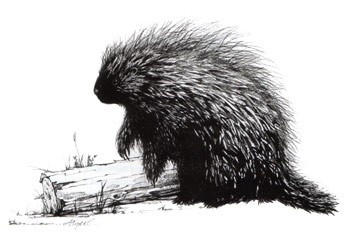
Most of us have been at least annoyed, if not infuriated, by porcupines from time to time. Their desperate need for salt in the summer months gets them in big trouble around the house. They spend the night chewing on tool handles, sap lines, electrical cables, tires, brake lines, canoe paddles, and the house itself. We once put out a salt block to try to keep porcupines from gnawing at our camp, and the result was two of them waking us with a loud, squealing, midnight fight over the salt. Shortly after I got out of bed to throw the lump far into the bushes, they both found it and resumed their noisy squabble.
In winter, porcupines live mostly on bark, along with some conifer foliage, leaving highly visible barkless limbs and trunks, both near the ground and high in the trees. This confirms their status as pests in many people’s minds. Indeed, it is distressing to see a nice sugar maple that has had its bark removed in big patches, ruining its timber potential and endangering its life.
Porcupine numbers were very high in the Northeast beginning about 75 years ago. In Vermont, there was a bounty on porcupines from 1903 to 1953, and in 1979, New Hampshire became the last state to give up on this not-very-successful strategy. Porcupines seemed to thrive despite bounties, poisoning campaigns, and countless bullets.
Though porcupine populations do fluctuate naturally, apparently on an 11- to 22-year schedule, it is the reintroduction of fishers, a tactic adopted by fish and game departments in the Northeast beginning in the 1960s, that has caused their numbers to drop dramatically. Studies in other parts of the country confirm that after fishers have become established, the porcupine population plummets to a small fraction of its former size.
Around here, other predators don’t have much success against the porcupine because of its sophisticated weapon, the quill. Extremely sharp, barbed at the tip, and stiffened by a spongy filling, quills are released into an adversary only as a last resort. If possible, a porcupine will climb a tree. If not, a visual warning is provided by its white-tipped quills that stand out against a darker background. Next, it will clack its teeth, and last, it will raise its quills and emit a nasty smell. If that doesn’t stop the attacker – most often the case only with naïve dogs – the quills are used. Once the quill penetrates, the tiny, one-way barbs coating the business end can pull it in even deeper.
My own attitude towards porcupines has improved enormously now that there is not an endless supply of them. Seeing one of the little fuzzballs high in a tree is a welcome sight.
The poor porcupine has a truly miserable winter diet: high in fiber, low in nitrogen, and laced with the tannins and terpenoids that trees produce to deter browsing animals. Still, they’re better than most ruminants at digesting highly lignified fiber, using (instead of multiple stomach chambers) an oversized area at the beginning of the large intestine, called a cecum. A porcupine keeps food in its digestive tract for over 38 hours, nearly twice as long as a typical animal that digests food in the same manner. This extended stay allows more time for microbes and digesting enzymes to break down fiber. Porcupines make the most of their low-nitrogen diet by losing only 11 to 29 percent as much nitrogen in fecal matter as other rodents.
Even with these adaptations, winter is not an easy time, and porcupines lose between 17 to 31 percent of their fall weight between November and April. During the growing season, they eat relatively nutritious items that are low in fiber: grasses, the buds and leaves of trees and herbs, acorns, and apples.
Porcupines mate in September or October, and the infant is born in the spring, about 210 days later. Apparently, there is never more than one baby porcupine. Its eyes are open at birth, and its quills harden within an hour.
In winter, deep, rocky dens are much warmer than holes in logs or big hollow trees, so they are a porcupine’s first choice. The expansive crowns of large, old trees are preferred for winter feeding, and, if they have cavities, they often provide housing as well.
Porcupines can do a lot of damage to trees, but the large, old cavity trees that they prefer are not likely to be particularly valuable for timber, nor are the trees that typically grow on the thin soils in the vicinity of the rocky outcrops that porcupines use for dens. Normally, these slowpokes don’t travel far from their dens in winter, but localized damage to trees is occasionally severe, and the porcupine will never be popular with everyone – especially after the dog gets a snoutful of quills.

